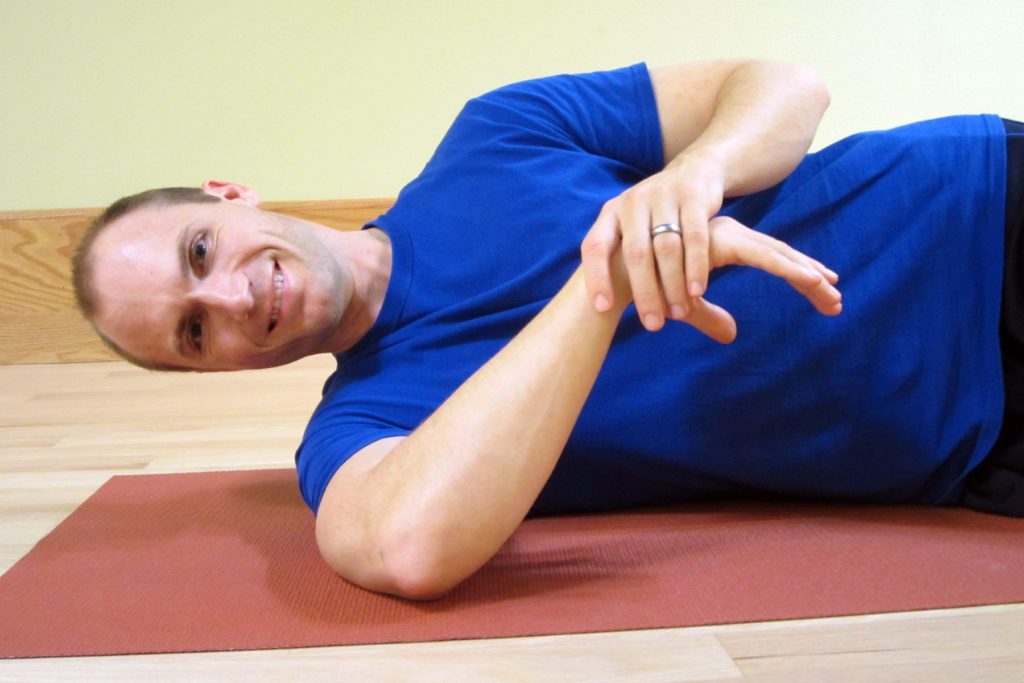Shoulder pain is one of the most common ailments treated by physical therapists. There are many potential causes of shoulder pain, but the two primary issues to consider include poor mobility and muscle imbalance. The key to treating most common shoulder related pain is to improve your posture while focusing on thoracic mobility, shoulder position, and proper shoulder strengthening.
Poor Mobility
The most common reason for mobility issues is poor posture. Poor thoracic mobility and tightness in the posterior capsule of the shoulder are the most common contributors to the lack of mobility which can ultimately lead to shoulder pain.
Mobility issues can occur if you adopt a chronic forward head with rounded shoulders posture. As this position becomes more chronic, the thoracic vertebrae lose backward mobility (extension). This happens in conjunction with shortening of the pec minor (which is located underneath the pec major) and causes the shoulders to roll forward. The forward shoulder posture causes the humeral head (arm bone) to be positioned more forward.
This causes tightness in the posterior (back) portion of the shoulder joint which affects the natural roll and spin motion of the joint. The alterations of the roll and spin motion combined with alterations in shoulder blade motion negatively affects the mechanics of the shoulder joint. The alteration in mechanics is what ultimately leads to pain as the rotator cuff or biceps tendons become impinged, irritated, and painful.
This is commonly referred to as Shoulder Impingement Syndrome. Shoulder impingement pain is often associated with pain reaching overhead, behind your back and/or out to the side. Those who experience it may feel weaker in the affected shoulder and experience pain when sleeping on the affected side.
Perform the following stretch to address shoulder posterior capsule tightness. Lie on the side of the affected shoulder. Be sure to support your head with a pillow. Your arm should be straight out from your body with your shoulder tucked under your body. The goal is to pin your shoulder blade down with the floor. Gently push your arm down (as shown). You should feel a gentle stretch. Hold for 30-60 seconds for two to three times. Perform once or twice per day.

In case you haven’t already subscribed to my e-mail list, please take a moment to do so in order to access my FREE resources, including My Top 8 Stretches to Eliminate Neck, Upper Back, and Shoulder Pain. It’s a downloadable .pdf file with my recommended stretches and exercises to address poor thoracic mobility and pec minor tightness. These simple exercises (with complete instructions and photos) will help you to improve thoracic mobility and can be performed at home.
Muscle Imbalance
Muscle imbalance is often an associated causative factor for shoulder pain. In addition to mobility issues, altered strength and muscle activation patterns are also related to shoulder pain and shoulder impingement syndrome. The reasons for muscle imbalance can vary, but are often associated with poor posture and/or cervical/neck related issues.
Two common muscles that must be strengthened in order to insure proper shoulder mechanics are the lower trapezius muscle and the supraspinatus muscle (which is one of four rotator cuff muscles).
The rotator cuff muscles are responsible for the stability of the shoulder and proper roll, glide, and spin of the ball and socket shoulder joint.
The lower trapezius muscle is responsible for proper shoulder blade timing and rotation during arm movements. It helps in maintaining a proper upright posture.
For three easy and effective exercises to perform to improve your lower trapezius and rotator cuff muscle strength, please refer to Exercises for Lower Trapezius and Rotator Cuff Muscle Strength.
Most shoulder symptoms typically resolve when thoracic mobility and strength in the shoulder is improved. Shoulder impingement is painful, but worse yet if left untreated. It can lead to fraying of the rotator cuff tendons (and ultimately, a rotator cuff tear). It’s always best to be proactive and address the causative factors early.
If you’re not improving or your symptoms worsen, consult with your medical provider to determine if other causes are contributing to the problem. The American Physical Therapy Association (APTA) offers a wonderful resource to help find a physical therapist in your area. In most states, you can seek physical therapy advice without a medical doctor’s referral (although it may be a good idea to hear your physician’s opinion as well).
If you’re experiencing shoulder pain, do you think either poor mobility or a muscle imbalance is causing it? How can you improve your thoracic mobility and strength in your shoulder? Please share below.
If you have a question that you would like featured in an upcoming blog post, please comment below or submit your question to contact@thePhysicalTherapyAdvisor.com. Be sure to join our growing community on Facebook by liking The Physical Therapy Advisor!
